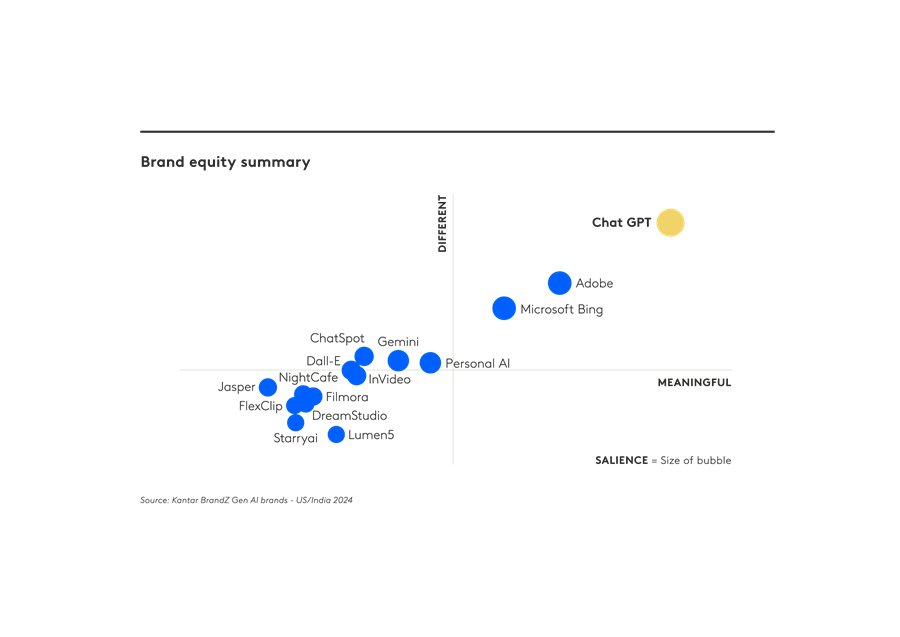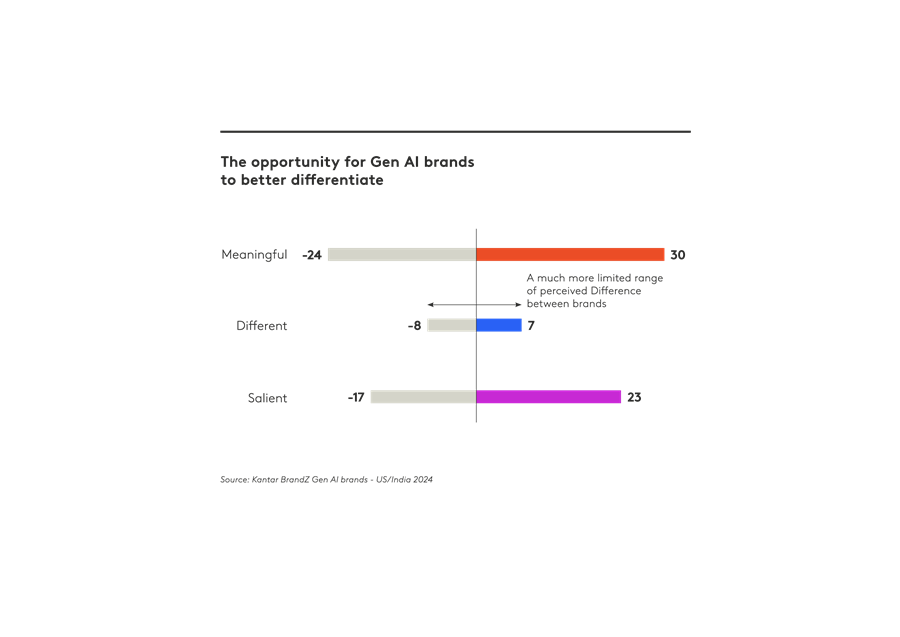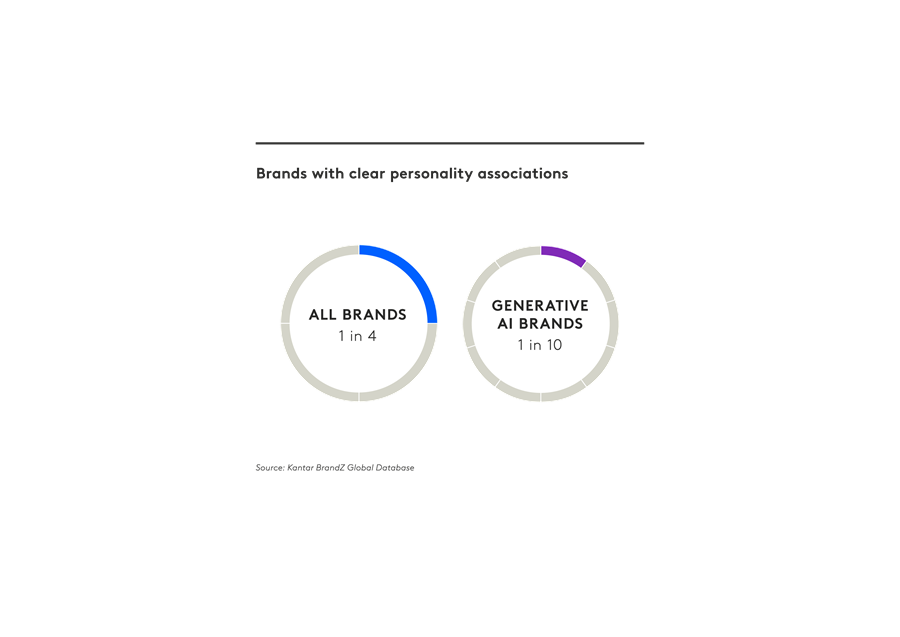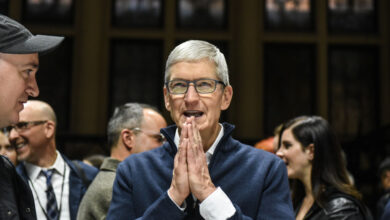The pivotal brand opportunity for generative AI

There’s equal excitement in the boardrooms of the owners of these increasingly impressive generative AI platforms, as development teams assemble and innovate at warp speed, desperate to maintain an advantage and remain at the vanguard of innovation. These CEOs, CFOs, and CTOs will be just as excited as those outside of the AI bubble, but the C-suite member that truly holds the key to success for these businesses is none of these – it’s the CMO (assuming they even have one!).
As with many brands, perception of capability can be just as important as actual capability, at least when framing a first encounter against a backdrop of an array of seemingly very similar offers. Delivery on these perceptions then becomes key, but in commodifying spaces, being the first to secure an initial interaction can prove crucial to adoption – which is where the power of brand can play such an important role.
We’re in the midst of a fast-accelerating arms race of technical capabilities, many of which remain barely sensical to the still inexperienced ‘end user’ in terms of how these could be applied to our own lives (notwithstanding the fact that many of us are in fact already regularly applying many of these capabilities without even noticing them, such has been the speed of proliferation). But what if these competencies and skills could be better positioned and delivered in a way that curates, frames, and personalises in an additive way, attracting users and most importantly, supporting their ongoing interest and attention? Welcome to the world of creating brands, generative AI tools – we’ve been expecting you. As the scene continues to commoditise, this is likely to become a critical battleground in influencing choice, usage, and preference. It’s time to move from the solely technical to the identifiably personable, and marketing has a very important role to play in transforming technological algorithmic wizardry into a ‘living and breathing’ brand. The battle for brand in the world of artificial intelligence has very much begun.
Clearly the AI arena comprises a complex language of widely different capabilities, from conversational applications to modified search engines, to corporate brands and foundational models. So, to assess the formative ‘generative AI brand landscape’, Kantar BrandZ conducted a study amongst 800 consumer users of AI tools, in the US and India, which included fifteen consistent tools across these markets, and deployed Kantar’s Meaningfully Different Salient (MDS) brand equity framework. The intention was to reflect the current reality of how these tools are positioned to, understood, and used by consumers (though this is such a fast-moving space, since this data was collected Google’s Bard has been re-launched as Gemini for example).
Results showed several interesting things. Firstly, that (the OpenAI-owned) ChatGPT is the current dominant player in both territories and has already established strong brand equity since its initial release at the end of 2022. As an aside, the tool is reportedly on track to bring in $2 billion in annual sales after launching its first subscription-based product. It amassed a monumental 100 million users within two months of initial release (it took Facebook and Netflix four years and ten years respectively to reach the same number of active users). ChatGPT’s current dominance of the user base aside, very few competitors come close even in brand equity terms. Microsoft Bing and Adobe are the only other two players currently viewed as reasonably Meaningfully Different (i.e. having strong brand equity) by users, and compared to ChatGPT at least, even these two lag significantly in terms of their comparative salience.
Brand equity summary
What’s also striking is the lack of perceived differentiation between brands in this nascent space. While the range of Meaning (a combination of relative relevance, and depth of emotional connection) and Salience (coming easily to mind) are relatively broad between brands, users simply do not see a great deal of difference between each brand, which suggests that current capabilities are one, perceived to be very similar, and/or, two, not well understood. So, if these tools are struggling to land and differentiate their technological advantages, how else could they set themselves apart and attract influential early adopters and encourage potentially pivotal first-time usage among the masses as the reach of this technology proliferates?
AI brands to better differentiate. 
While technical prowess is certainly a hygiene factor, one way is by communicating differentiating brand associations aside from the purely technological. An increasingly common route for positioning and delivering these services is to pursue personification as a means of attraction, accessibility, and curation of capability.
Humanising ‘computing’ has long been a means of normalising and demystifying the otherwise impossibly technical. One of the original first movers in AI, IBM’s Watson, was introduced way back in 2007 as a means of competing against human contestants on the US gameshow Jeopardy!, and still carries the name of the company’s founder and inaugural CEO Thomas J. Watson today – now as an AI software platform. The increasing prevalence of personified virtual assistants is further evidence, as is the ability of numerous generative AIs to literally speak to users using a range of global and regional accents. However, it seems the goal of meaningful personification remains a long way from being fulfilled for many and is certainly yet to filter through to users in terms of additive and differentiating brand associations.
To be fair, these associations are hard to achieve for any brand – only one in four of the thousands of brands in the Kantar BrandZ database has successfully established clear personality associations (and remember, many of these brands have been actively communicating with their audience for decades). Within generative AI tools, this proportion falls dramatically to just one in ten brands – a clear opportunity to establish and press home a differentiating advantage.
Brands with clear personality associations.
In line with this, these tools are yet to be linked with high quality advertising content – none are currently well defined in terms of their perceived strength in this area – rather, current strengths lie in perceived technical capabilities and convenience alone. Concerted efforts in identifying suitable non-technical associations and investing in communicating these through high quality content, are likely to pay a differentiation dividend and support the leap from ‘technology platform’ to ‘attractive, engaging, and useful brand’. Less artificial intelligence, more common-sense marketing if you will. Game on.
So, in summary:
• Generative AI is developing at pace but remains a long way from developed in terms of brand and marketing strategy and investment
• The role of brand is currently a hugely underestimated opportunity for generative AI tools as a means of connecting with and guiding everyday consumers. The current focus on establishing technological superiority will inevitably tend towards commoditisation as adequate tech capability becomes a hygiene factor
• Clearly defining an emotional positioning offers even more potential for growth for these tools – success here will pay back a differentiation dividend as more and more consumers adopt.



